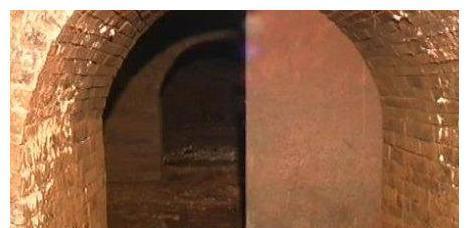In the period of feudal society, the ancients paid great attention to the thick burial system, especially in the imperial aristocratic circles, they would repair the mausoleum in advance and prepare luxurious funerary items. However, after the ancient tomb of Luoyang Jincun was discovered, a "strange" thing happened, and a "fake jade coat" was unearthed from the mausoleum.

(All pictures in this article, all from the network, thanks to the original author, if you infringe your rights, please contact the author of this number to delete.) The picture has nothing to do with the content, please do not enter the seat)
In the summer of 1928, the villagers of Luoyang Jin Village were farming in the fields, and when a villager was weeding with a hoe, he suddenly felt that the hoe hit something hard, and after he turned the soil over, a large stone slab appeared. Out of curiosity, the villager called several villagers around him and worked together to pry open the large stone slab.
After the stone slab was pried open, a black hole appeared, and the farmer took advantage of the sunlight to look inside and found several artifacts. When the village chief learned the details, he suspected that the villagers had found the tomb, so he immediately reported the news to the local cultural relics research institute.
When the experts received the news, they rushed to the scene with professional tools, and after the field investigation, there was indeed a mausoleum in the area. The mausoleum has been damaged, and experts have decided to carry out rescue excavations, in which they have unearthed a large number of bronzes, jades, metal objects, etc.
After these artifacts were transported back to the institute, a "jade coat" successfully attracted the attention of experts. The jade garment consists of 369 matchbox-sized pieces of jade, some of which are decorated with four square divine beasts, namely the Eastern Green Dragon, the Western White Tiger, the Southern Suzaku, and the Northern Xuanwu. There are small perforations on the jade pieces in the corners, through which the ancients can connect the jade clothes with the clothes. On the whole, this jade robe is very tall, so experts deduce that the mausoleum is likely to be the tomb of the nobility.
In order to determine the dynasty to which the jade coat belonged, experts conducted a professional analysis of the jade pieces on the jade coat. However, after the test results came out, the look of the experts was somewhat wrong, and the jade pieces on the jade coat were not the jade of real value, but the glass products. That is to say, this jade robe is not worth anything at all.
Why did the owner of the tomb use glass to make a fake "jade coat" and put it in the mausoleum?
According to relevant records, the origin of jade clothes can be traced back to the Eastern Zhou Dynasty. In the Eastern Han Dynasty, a strict hierarchy of jade clothes was implemented, such as: after the death of the emperor, he was eligible to wear a golden jade robe, the princes could only wear silver jade after their death, and the general nobles could only wear copper jade.
After the nobles of the Han Dynasty ate and dressed without worry, they did not mean the meaning of "cangxiaoshi and know etiquette", but were obsessed with "luxury style", only knew how to enjoy all day, and did whatever it took to benefit. When someone in the family died, some of the fallen noble families basically could not come up with decent funerary goods, but the face of the family could not be lost, so the nobles started the idea of "glass" jade clothes.
In the Han Dynasty, glass slides could already be mass-produced with molds, and craftsmen only needed to pour the glass solution into the porcelain mold and wait for a moment of incense to be formed. Jade garments made of glass are very cheap, and the difference between the two is basically indistinguishable with the naked eye. Therefore, the glass version of the "jade coat" was welcomed by the "fallen" aristocratic class, and it was definitely a must-have for filling face in the mausoleum.
Live to enjoy, after death luxury, no money to counterfeit. Late Han Dynasty. After the formation of such a "bad" atmosphere, can the imperial court not perish? And the excavation of this item also always warns future generations that the luxury of punching a swollen face and being fat is really undesirable.